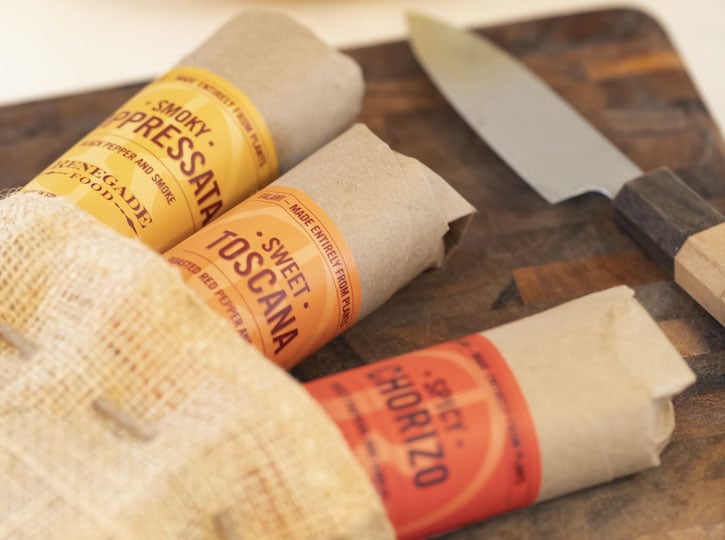Charcuterie boards are a hot trend in appetizers, so let’s create an even more appealing version by making it completely plant-based. A vegan charcuterie board is fun, festive, and flexible, and a fantastic way to use artisan plant-based salami and cheeses. Serve with your favorite vegan wine, and you’ve got a guaranteed palate-pleaser.
 Photo: Veronica Darrah/Renegade Foods
Photo: Veronica Darrah/Renegade Foods
Vegan charcuterie boards are welcome any time of year, especially appealing in the summer and the winter holidays, when you’d rather spend more time with your guests than in the kitchen. Truthfully, the charcuterie board is more about arranging than anything else — cutting and prep are minimal.
A sneaky centerpiece: Think of the charcuterie board as a kind of cousin to Italian antipasto or the Middle Eastern mezze platter. Charcuterie is a French term referring to the preparation and serving of cold cured meats.
We won’t be doing that, of course. The “meat” I used in my recent creations is Renegade® plant-based salami, which has the chewiness, savor, and spice of a cured meat, with none of the bad stuff.
Yes, the charcuterie board is an appetizer, but it’s so satisfying that you don’t need much more food after it’s served.
Whenever I’ve done so, the guests were so well sated that following up with soup or salad (with crusty bread) seemed more than sufficient. Then, you can rest for a bit before serving a light dessert!
 Photo: Peter Quinn/Renegade Foods
Photo: Peter Quinn/Renegade Foods
Note: Renegade Foods kindly sent samples, but this is NOT a sponsored post; all opinions are those of TheVeganAtlas.com.
Renegade salami is based on vital wheat gluten (the main ingredient in seitan), and depending on the variety, also incorporates miso, rice koji, roasted bell peppers, shiitake mushrooms, nutritional yeast, and other wholesome ingredients.
Lots and lots of spices and seasonings too, of course. So take note, this product isn’t gluten- or soy-free.
Great reasons to serve a vegan charcuterie board at your next gathering
- It’s flexible and fast — you need not follow a specific recipe.
- For the little effort it takes, it yields a huge “wow” factor.
- It’s open to seasonal variations.
- A charcuterie board makes a perfect partner for wine or your favorite cocktails. See this page for useful notes on wine pairings.
- It’s finger food, so you don’t need a lot of cutlery. You can get away with cocktail toothpicks or tiny forks, Small plates and napkins are always welcome, of course.
Endless possibilities for your vegan charcuterie board
You can make this with different ingredients each time, presenting an array of flavors — salty, tart, sweet, mellow; and textures — soft, crunchy, chewy.
There really are no rules, and much depends on the size of your board and the number of people being served. For the board, you can use any kind of large cutting board, a wooden pizza board, a shallow-rimmed serving tray — even a no-longer-used chess board!

Must-haves
- Plant-base cured or sliced “meats”: Plant-based cured meat, and/or deli slices. I’ve been using Renegade vegan salami, which comes in several varieties, including Smoky Sopressata, Sweet Toscana, and Spicy Chorizo. You can also use plant-based deli slices like those made by Tofurky, Lightlife, and others; they look nice rolled up and arranged on the board. Vegan pepperoni works, too.
- Vegan cheeses: There are so many good choices when it comes to vegan cheeses these days. Use two or three different kinds — slices, hard blocks (diced), and/or semi-soft, spreadable like Treeline and Miyoko’s.
All kinds of add-ons
Use between 3 and 4 of the following — or more. If you’ve got room on your board, the more ingredients, the merrier. Choose from among the following categories of ingredients to fill in your board, making sure that you have an array of contrasting flavors and textures.
- Breads and crackers: Mini-baguettes, whole-grain crackers, crispbreads. Use your favorites.
- Dried fruits: Citrus, cranberries, apricots, mangoes, figs (Turkish or mission)
- Fresh fruits: Apples (sliced), blueberries, figs (halved), berries (blackberries, blueberries, raspberries, strawberries), seedless red or green grapes, melons (peeled and sliced), pears (sliced), pomegranate seeds
- Nuts: Mixed nuts, pecans, cashews, walnuts. Natural candied nuts are nice, too.
- Olives: Your favorite brine-cured olives, black or green, from the olive bar
- Jam or all-fruit preserves: If you’re low on fresh or dried fruit, jam adds a nice contrast to the briny flavors in the mix
- Pickles: Any good-quality pickles, sliced or in spears; half-sour is especially good. And not just pickled cucumbers — any kind of pickled vegetable will add a welcome briny note to your board. Pickled mushrooms, pickled cauliflower, etc.
- Vegetables: Bell peppers (in long narrow slices) celery sticks, cherry tomatoes, radishes (any variety, including watermelon radish)
Arrangement tips
- Arrange your ingredients fairly tightly on the board — they go quickly and the board thins out fast.
- Group some ingredients in 2 or 3 places on the board; scatter others (like small bunches of grapes, nuts, or pomegranate seeds) all over.
- Replenish ingredients as needed. For example, if you have a cheese spread and the breads or crackers, simply add more.
See more timely ideas in this site’s Tips & Trends.


Leave a Reply